
A beefsteak, often called just steak, is a flat cut of beef with parallel faces, usually cut perpendicular to the muscle fibers. In common restaurant service a single serving has a raw mass ranging from 120 to 600 grams. Beef steaks are usually grilled, pan-fried, or broiled. The more tender cuts from the loin and rib are cooked quickly, using dry heat, and served whole. Less tender cuts from the chuck or round are cooked with moist heat or are mechanically tenderized.

An omelette is a dish made from eggs, fried with butter or oil in a frying pan. It is quite common for the omelette to be folded around fillings such as chives, vegetables, mushrooms, meat, cheese, onions or some combination of the above. Whole eggs or egg whites are often beaten with a small amount of milk, cream, or water.
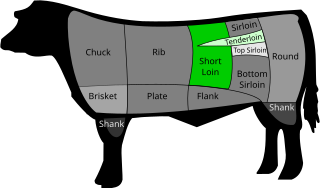
The T-bone and porterhouse are steaks of beef cut from the short loin. Both steaks include a "T"-shaped lumbar vertebra with sections of abdominal internal oblique muscle on each side. Porterhouse steaks are cut from the rear end of the short loin and thus include more tenderloin steak, along with a large strip steak. T-bone steaks are cut closer to the front, and contain a smaller section of tenderloin. The smaller portion of a T-bone, when sold alone, is known as a filet mignon, especially if cut from the small forward end of the tenderloin.
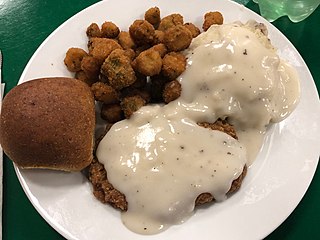
Chicken-fried steak, also known as country-fried steak, (CFS) is an American breaded cutlet dish consisting of a piece of beefsteak coated with seasoned flour and either deep-fried or pan-fried. It is sometimes associated with the Southern cuisine of the United States. It is breaded and fried with a technique similar to the more common fried chicken, hence "chicken-fried". When deep-fried, it is usually referred to as "chicken-fried steak". Pan-fried versions are typically referred to as "country-fried steak".
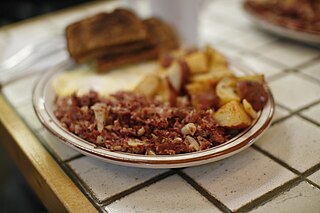
Hash is a dish consisting of chopped meat, potatoes, and fried onions. The name is derived from French: hacher, meaning 'to chop'. It originated as a way to use up leftovers. In the U.S. by the 1860s, a cheap restaurant was called a "hash house" or "hashery."

Chateaubriand is a dish that traditionally consists of a large front cut fillet of tenderloin grilled between two lesser pieces of meat that are discarded after cooking. While the term originally referred to the preparation of the dish, Auguste Escoffier named the specific front cut of the tenderloin the Chateaubriand.

Steak tartare or tartar steak is a French dish of raw ground (minced) beef. It is usually served with onions, capers, mushrooms, pepper, Worcestershire sauce, and other seasonings, often presented separately, to be added to taste. It is often served topped with a raw egg yolk. It is similar to the Levantine kibbeh nayyeh, the Turkish çiğ köfte and the Korean yukhoe.

Steak and kidney pie is a popular British dish. It is a savoury pie filled principally with a mixture of diced beef, diced kidney and onion. Its contents are generally similar to those of steak and kidney puddings.

A schnitzel is a thin slice of meat. The meat is usually thinned by pounding with a meat tenderizer. Most commonly, the meat is breaded before frying. Breaded schnitzel is popular in many countries and is made using veal, pork, chicken, mutton, beef, or turkey. Schnitzel is very similar to the dish escalope in France and Spain, panado in Portugal, tonkatsu in Japan, cotoletta in Italy, kotlet schabowy in Poland, milanesa in Latin America, chuleta valluna in Colombia, chicken chop in Malaysia, and chicken-fried steak and pork tenderloin of the United States.

Salisbury steak is a dish originating in the United States and made from a blend of ground beef and other ingredients, being considered a version of Hamburg steak. Today, Salisbury steak is usually served with a gravy similar in texture to brown sauce, along with various side dishes such as mashed potatoes and cooked vegetables. It is a common menu item served by diners, and is frequently available as a TV dinner in supermarket frozen food sections.

Beef Wellington is a steak dish of English origin, made out of fillet steak coated with pâté and duxelles, wrapped in puff pastry, then baked. Some recipes include wrapping the coated meat in a crêpe or dry-cured ham to retain the moisture and prevent it from making the pastry soggy.

Anticuchos are popular and inexpensive meat dishes that originated in the Andes during the pre-Colombian era, specifically in the Antisuyu region of the Tawantinsuyu. The modern dish was adapted during the colonial era between the 16th and 19th centuries and can now be found in Peru.
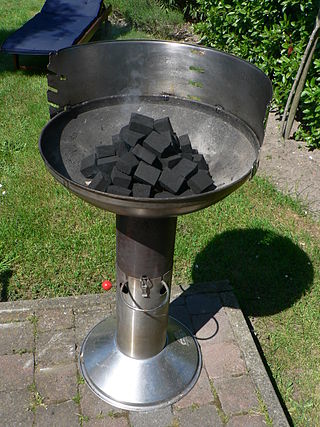
Barbecue varies by the type of meat, sauce, rub, or other flavorings used, the point in barbecuing at which they are added, the role smoke plays, the equipment and fuel used, cooking temperature, and cooking time.
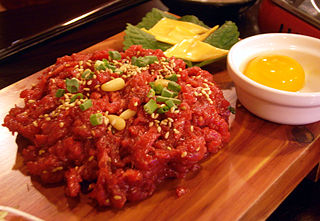
Yukhoe is a raw meat dish in Korean cuisine. It is most commonly made of beef but it can come in various kinds and cuts of meat.

Korean barbecue is a popular method in Korean cuisine of grilling meat, typically beef, pork or chicken. Such dishes are often prepared on gas or charcoal grills built into the dining table itself. Some Korean restaurants that do not have built-in grills provide customers with portable stoves for diners to use at their tables. Alternatively, a chef uses a centrally displayed grill to prepare dishes that are made to order.

The cuisine of Gower, a peninsula in south Wales, is based on ingredients grown, raised or collected on or around the peninsula. The cuisine is based on fresh ingredients with recipes based around a fish or meat dish. Until the twentieth century, the peninsula was virtually cut off from other markets due to poor roads, and no rail connection. The result was that Gower became self-sufficient in food.

A steak is a thick cut of meat generally sliced across the muscle fibers, sometimes including a bone. It is normally grilled or fried. Steak can be diced, cooked in sauce, such as in steak and kidney pie, or minced and formed into patties, such as hamburgers.

Breaded cutlet or braised cutlet is a dish made from coating a cutlet of meat with breading or batter and either frying or baking it.

















